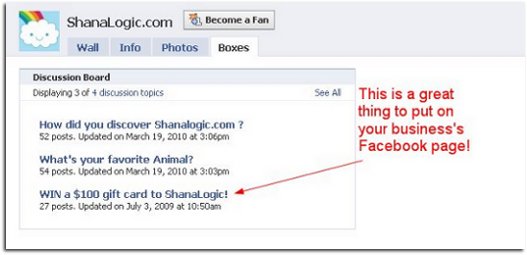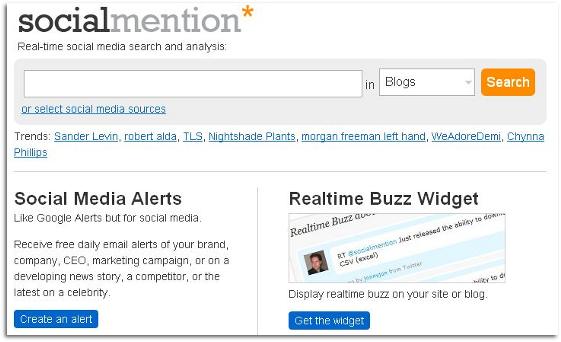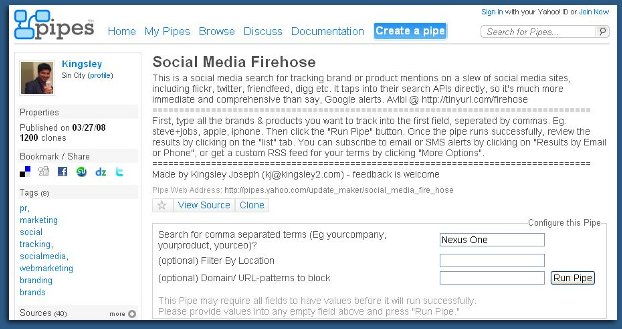Growing rapidly, with about 200 million registered users and estimated to surpass the 15 million adult users in the US in 2011, Twitter has proved as a very successful venture in the past 3 years. Based on acquisition offers, the company value has increased from $3.7 billion in 2009 to about $10 billion in the closing months of 2010. Yet, the owners are probably not going to sell it any time soon.
Instead, they want to turn Twitter into more profitable website. And the best way to ear money for an internet website is, of course, advertising. Currently, there are three options for advertising on Twitter – Promoted Tweets (that look like normal tweets, but are said to reach not only your followers but a significantly larger crowd), Promoted Trends (advertising at the Twitter home page) and Promoted Accounts (Twitter recommends certain accounts as “worth to follow”).
The problem, however, is that every potential advertiser has to submit an advertising request, which is then reviews by the Twitter staff and is either approved or not approved. The approval process is manual and, as a result very slow. Many small- and medium-sized businesses simply give up, unwilling to wait, and turn to other advertising options – such as Google Adwords and Facebook Ads.
Although Twitter is not going to remodel the advertising scheme completely, it is done the first step, reportedly increasing the “advertising team” to assize of 35 workers (a notable 10% of the company personnel). Their primary task will be to improve response times and also to contact potential advertisers – those who had previously expressed interest in using Twitter in their campaigns.
Recent consumer study conducted by comScore and GroupM revealed that although 64% of the users are likely to follow a brand on Facebook and/or Twitter, search engine is still the most popular initial step for the majority of purchases made online. The study shows that nearly 60 percent of future buys originate within the search engine websites, with social media coming in the third place with 18% behind company websites (24%). And of those 18%, nearly half will eventually turn to search at some stage of their research. Similarly, only 40 percent of those that use search as their initial step will use social media throughout the purchase.
Moreover, almost no users (less than 1%) use Social Media and do not use search, while the search beats the “search+social media” combination 50 to 49 percent. Only 45 percent, though, use search throughout their research with 26 percent stating that they only use search in the beginning of the process.
The study also shows that customer reviews are something customers are looking for – making the recently reported idea of “SearchReviews.com” pretty viable. 30% of the responders said reviews are the most important thing to them. Social networks were selected by 17% of the users, and video sharing finished third with 14%.
Notably, the study only researched COMPLETED buys. So, maybe social media is simply good at preventing future purchases? After all, reading a page of negative opinions about a product can drive you away from it, and sometimes the whole idea of purchasing a certain accessory can become obsolete…
Twitter has mad a strong progress in the recent years. It has been a useful tool both for fun and, of course, business. Respectable companies are tweeting, telling their followers about company news, promotions etc. It is only a matter of time for world’s most popular the micro-blogging platform to reach 200M registered users – the current figure being about 175 Million. People are sharing their thought and ideas using Twitter at astonishing rate, reportedly over 65M tweets per day.
Notably, according to recent research, only 50% of the tweets are in English. It seems that Twitter decided to carry on its success in the Asian market as Japanese is the second popular tweeting language and Malay is fourth with Portuguese being third due to the tool’s extreme popularity in Brazil. However, instead of addressing the challenging Chinese market, Twitter skippers have picked Korean as the seventh supported language (don’t confuse with the messages language, which can be almost anything, form Tamil to Hebrew and Arabic) in addition to the existing English, German, French, Spanish, Italian, and Japanese.
The decision is based on the amazing growth rate of South Korean Twitter users (almost ten times in 2010) and the country being relatively advanced in technological terms. The relevant iPhone app and Twitter mobile for Android in Korean have also been launched, making tweeting easier for the South Koreans.
When “the internet” was introduced, its main purpose – and the idea behind it – was to allow educational and research institutions to share data. That was back in the 1980s. Of course, since then internet has passed several phases. Globalization and technology have joined forces to make the WWW a must-have feature for almost every household. In the start of the 21st century the internet was mainy about reading and gathering information. Nowadays, it is mostly about sharing. Facebook success is adorable, however it is the social network concept that made it possible – of course, it was somewhat altered and some even would say reinvented by Mark Zuckerberg and Co. to speed up the growth.
Anyway, there are many others that wish to exploit this approach. The Russian “Vkontakte” (connected), Chinese-oriented “QZone”, Orkut (owned by Google and extremely popular in Brazil and India) are just a few of the social networking websites. With local social networks already present, the next step, it seems, is to create a more “targeted” communities for those who have specific common interest.
SolaMaps, launched recently by Australia-based Stewe Edwing and his fellow green energy enthusiasts is one such an example. The idea of the network is to connect solar energy users all over the world, enabling them to share tips, ideas and experience with one another. By attracting more and more users, the site founders also hope to increase the global awareness of environmental issues. “You Don’t Need A Solar System To Join the SolaMaps Action!” the website slogan states. All you need is a passion for renewable energy.
The global village and the internet era is everywhere. Long gone are the times when Church opposed science– Vatican itself is happy to use the most advanced technology in the world. And internet is no exception, it seems. In his latest statement, the Pope has shown good familiarity with social networks and their popularity among teenagers, pointing out pros and cons of digital communication.
Pope Benedictus XVI praised the prospects offered by the new technology saying that “if used wisely, they can contribute to the satisfaction of the desire for meaning, truth and unity which remain the most profound aspirations of each human being”, and emphasized that digital communication is a form of sharing.
His Holiness also warned about misleading by creating a “fake” personality in quest for “followers” and “friends” and stated that “there is the challenge to be authentic and faithful”. The Pope invited the Christians to join the global network as relationship is the fundamental need of a human being, and concluded his address with Apostolic blessing to all those that “make good use of their presence in the digital world”.
We all know Facebook is one of the fastest (if not THE fastest) growing websites around. The popularity of Facebook is amazing and the number of hours spent by the users on their Facebook pages, playing games, posting and tagging photos is increasing every day.
And here is another indication of the website’s growth: unique visitors. This is a statistic that keeps track of websites (really webpages) being accessed by users based on their IP (which is very similar to physical location). Google is leading the way since very-long-time-ago, with an average of about 1 billion hits a month, and Microsoftis is second, about 100 million unique visitors behind.
According to Geek.com, Yahoo! has been pushed down to fourth place in November 2010, by (guess who?) Facebook, of course. The numbers reported (648 million for FB and just over 630 million for Yahoo!) were supplied by comScore, providing yet another confirmation of Social Media progress towards taking over the internet.
Traditional company managers and advertising professionals who think Facebook is a way for college students to gossip, think again! Professionals in a number of fields make up a significant portion of the Facebook population. Adults in the general population are another group using this form of social media. Marketing “experts” who survived and flourished in the world of traditional media will need to gain knowledge and skills with Facebook and other online methods.
Those who decide to use Facebook as part of an overall marketing system should understand that this is a very personal method of presentation. Your business personality will need to be closely tied to your personal identity. The vast majority of Facebook users expect authenticity if not complete openness.
Facebook as a digital form of you! If you and the others who work with you can grasp this concept you don’t need to be an Internet expert or a technology fanatic. Consider that some of the most valuable customers and clients are using Facebook. It’s the new community and the companies that aren’t using it might not make connections with their target demographic.
Think “Social Media”
 Under the social media category you will find blogs, forums, sites that share videos, podcasts and, of course, sites generated by the users themselves. Facebook is one of the most prominent social-media sites today, bypassing MySpace. But in the ever-changing Web world even Facebook is just one of the important methods for online marketing.
Under the social media category you will find blogs, forums, sites that share videos, podcasts and, of course, sites generated by the users themselves. Facebook is one of the most prominent social-media sites today, bypassing MySpace. But in the ever-changing Web world even Facebook is just one of the important methods for online marketing.
If you are a numbers freak, heavily on statistics, graphs and charts to provide your marketing direction, consider this: More than 200 million people manage personal profiles on social networks. Millions more read daily journals and blogs on social-media sites.
Here’s the inside info from The New Community Rules: Marketing on the Social Web (Tamar Weinberg 2009), “Social media marketing (sometimes referred to by its acronym, SMM) connects service providers, companies and corporations with a broad audience of influencers and consumers. Using social media marketing, companies can gain traffic, followers, and brand awareness – and that’s just the tip of the iceberg.”
One of the key words in this marketing method is trust. Social-media marketing emphasizes the community, a collection of individuals, rather than the individual. Your focus should be on providing solutions and sharing what you know, rather than on controlling the customer’s mind with a carefully crafted advertising method. This larger process is considered “viral.” A Web-site viewer finds a nugget of information and spreads it. Others trust that person’s ideas and opinions on this subject. An entire community may adopt some of the better ideas.
Ideas and Tools
Some of the best ideas and tools for marketing your company or products on Facebook are:
If you still haven’t grasped the idea of using social media to market your efforts, don’t worry. This is a fundamental change in the way we look at marketing and at advertising. Perhaps a closer look at some of the individual tools and ideas would help.
For example, the profile page is not only a place to start, an introduction of you and your business it is also the place where you can put your message in words and images. You don’t have to carefully whittle and trim your advertising message so that it fits a particular magazine, newspaper or radio station. You still have to give careful consideration to your message of course but you can speak with some passion about your brand and your company.
Consider this: People who use social media are generally browsers. They may come across your profile page (and your marketing message) through the viral network mentioned earlier. As they move from one Facebook page to another they will develop trust for the ideas and products their friends recommend.
The Community Idea
When this sharing gets a foothold in the online community businesses may start to see the power of Facebook groups. These collections of like-minded individuals are not only customers they may also be partners and friends who use word-of-mouth tactics to spread your word. *There are some size limits for groups but this may change in the near future. But you can create new groups.
Combine the groups concept with additional pages and you are well on your way to using social media for successful marketing. With Facebook pages you can customize your message and provide the customer or client with a full experience of your brand, product or service. When you have a fan for your custom page this individual can (and will) share the page with friends. It’s an easy, free way to build viral marketing.
One of the most important questions you can ask when developing your social-media marketing plan is this: How do successful ventures spread the word about a special event or activity? Let’s look at an example. In the world of rock-and-roll music in the 1960s fans of a band told others and the audience grew quickly.
You can do this with your company events or activities through Facebook. (It’s still done in the rock-and-roll world!) You can get the word out to hundreds, even thousands, of people. Facebook marketing helps you build a community around each individual event, product or service and this is just the beginning of how Facebook can be part of your social-media marketing.

Using Facebook to market your business is one of the best ideas to come along in recent years. It shoulders some of the advertising burden and connects you with your customers. You have to have a personal Facebook account before you can set up a business account because business pages are created and maintained from within a personal account and has to be accessed via your personal login. If you try to start out setting up a business page, you’ll have to set up both at the same time, which is why it will ask for personal information.
Then, you have to become a fan of your business page before it can be seen when you search. But the actual setting up of your business page isn’t that hard. There are fields you have to fill in for the description of your business, your mission, how long you’ve been around, and stuff like that. What are the keys to having a good Facebook page that will serve your business well? Two important ones are accessibility and interaction.
The first screen shot shows part of the “Tips and Tools” page from the Facebook page of Nicorette, a company that makes nicotine gum for people who want to quit smoking. There’s an opportunity to share your story if you’re trying to quit smoking, and there’s a poll. If you were to scroll down further, you’d see that there’s a button you can click to get a coupon. So the page’s visitors have several chances to interact. The “Wall” for Nicorette has a number of sympathetic tips on how hard it is to quit smoking, etc., and visitors can comment and leave their own words of encouragement.

But not everyone has the kind of budget that Nicorette does, but you can still do a lot with a Facebook page for your business. The second screen shot shows the Facebook page of a business that sells handmade clothing and jewelry. It’s pretty simple. The Wall is used to post pictures of items for sale, and people can comment on them. The Boxes tab takes you to the page shown in the second screen shot. Again, it’s pretty simple, but as you can see there’s a link you can click to enter a contest to win a gift card. Links like that get plenty of clicks!

Once you get your business’s Facebook page up and operational, you can install various Facebook “apps” that will make it more interactive and appealing. You don’t have to have a lot of technical expertise to do this, either. They include social games and quizzes that you’ve no doubt seen if you follow friends on Facebook. While there are dozens and dozens of apps, there are a few top ones. First you need to know that FBML stands for Facebook Markup Language. You use it to add functionality to your Facebook page. The Facebook Static FBML application adds a box on your page where you can render either FBML or HTML to further customize your page.
You can use static FBML to add vertical navigation in the left hand column, which is familiar to most internet surfers. In it you can put links, promotions, and contact details. Add this app to your Fan page as a box, not as a tab. Then you add content to the box with standard HTML. In your sidebar, you might add icons or graphic buttons that link to other destinations your fans might like, such as your website, your blog, or your Twitter account. The sidebar will be visible regardless of what Fan Page tab your visitors happen to be using. When you’ve added your content and saved it, it will show up as a box on the tab marked “Boxes.” From the boxes tab, you can see if your HTML has rendered, and if it has, you can click on the pencil in the upper right hand corner and choose “Move to Wall Tab” to get your content to display in the left column navigation of your page.
People love contests, giveaways, and other promotions, and these are great ways to engage visitors and make them more familiar with your brand. The Promotions app lets you create and publish a contest on Facebook so that it is sociable and easy to share. Now, to use this app, you have to sign up for an account at wildfireapp.com. That’s because the content you create stays on the developer’s website. After you sign up and connect the app to Facebook, whatever promotions you create on wildfireapp.com will show up on the tab on your Fan page. You go through an easy step by step process to build promotions, where you’ll add dates, types of prizes, and entry fields for the entry form. You can also add stuff about rules and even add artwork to your promotions.
The thing about having your contest content housed on WildFire is that you can put it on other social networks as well, and even put it on your own website. Whatever changes you make to the promotions will update dynamically on all the locations where fans and customers interact with you. You should know in advance, however, that it isn’t free, even though setting up a WildFire account is free. A basic WildFire campaign costs $5, plus 99 cents each day the campaign is active. There are other WildFire promotion packages too, depending on your ideas an budget.
Here’s a great idea if your website includes video content. You can use the YouTube for Pages app to dedicate a tab on your Fan page to your YouTube channel. Again, this involves setting up a free account on involver.com. After it’s connected to your Fan page, you tell it the YouTube channel you want to get videos from. Your most recent upload or favorite video will be featured, and there will be thumbnails for earlier videos. The videos play directly on Facebook.
One of the best ways to get feedback on your business is with a poll. It also happens to be a great way to interact with your customers and fans. The Facebook Poll app is extremely easy to use. You don’t have to set up any type of third party account or anything. You connect it to your page and all the settings reside in your settings panel. You just set up your poll by stating the question and list multiple answers from which fans can choose. You poll can go on your Wall, on a custom tab, or in your left-column navigation. You can invite friends to answer the poll, and then they can share it. The results are right there on Facebook for everyone to see. Imagine adding a fun, interesting poll every week. You’ll give your fans a reason to check back often.

Used properly, social media can help you with market research, learn about the type of people interested in your business, and build your customer base with only the investment of time. Using social media to build your site traffic and improve visitor loyalty is one of the biggest trends for 2010, and small businesses everywhere are doing it to make their businesses better and increase their sales.
Even though there’s no way around the requirement for having good content, a social media campaign built as a framework around your great content can sincerely help your efforts along. And you can track your success due to your social media campaign pretty easily. Here’s a checklist of the things you should do to make your social media campaign work hard for you.
 1. Step 1 is the biggie: get involved. Social networking is a giant conversation between businesses and customers and among the customers. Setting up your presence on the big social media sites (Facebook and Twitter are the hot sites right now.) is easy and quick, and there’s no reason not to try it. You’ll be able to increase brand awareness and build up relationships with customers. The marketplace is heavily competitive, particularly with the world economy still lagging, so don’t miss out on the opportunities social media brings.
1. Step 1 is the biggie: get involved. Social networking is a giant conversation between businesses and customers and among the customers. Setting up your presence on the big social media sites (Facebook and Twitter are the hot sites right now.) is easy and quick, and there’s no reason not to try it. You’ll be able to increase brand awareness and build up relationships with customers. The marketplace is heavily competitive, particularly with the world economy still lagging, so don’t miss out on the opportunities social media brings.
2. Block out time or assign a staffer to dedicate to social media marketing. Just Tweeting something whenever you happen to think of it and have a minute or two isn’t good enough. Plan for daily updates. Write it into your schedule. It’s like exercising in that if you don’t schedule it and realize that it’s important, you won’t bother. Regular updating and interacting with followers are important enough that they should be part of your (or your staffer’s) regular work schedule.
3. Remember that social media participation is a give and take relationship. Signing up and spamming everywhere will hurt rather than help your business. Twitterers will stop following you the minute they think you’re only on there to spew links and bombard them with ads. It’s only 140 characters, but you can do a lot with it as far as making it actually say something.
4. Check and double check the quality and make-up of your content. If you put up a new “Top 50” list on your blog and each of the 50 items on the list come with an image, think about what happens if your dream comes true and thousands of visitors at once want to read it. Will it exceed your host’s processor’s bandwidth limitations? You’re better off using Picasa or Flickr for hosting your images so you don’t use up your hosting resources on extras.
5. Add social media vote buttons and badges. Sure, visitors can go to Digg.com and manually digg your blog post, but they won’t. Have a Digg button and make it easy.
6. Be aware of events that are going to swamp your social media posts. Huge news events like earthquakes and celebrity deaths are going to put the strain on the social media networks. It may be best to wait it out for a day or two. Avoid trying to compete with known big events like elections and holidays. Those are days when you can and should keep it light rather than announcing a new product.
7. The corollary to Step 6 is to pick a good time to launch something big. On what days do you pick up the most attention on Twitter and Facebook? What time of day is best? Do it then.
8. Keep a close eye on analytics during any social media campaign. Instant traffic stats are very helpful in finding out what’s working well and what isn’t. Tracking the number of inbound links both before and after a social media campaign is important, particularly if you’re doing a social media campaign as a consultant for someone else. You want to be able to see how well the campaign is working. SocialMention is a good website for tracking chatter about your brand on social media sites. The interface is very simple, as you can see in the screen shot. SEMrush (see screen shot) is a tool that lets you find out what a page is ranking for and other goodies like the Google keywords for a given site.

Social Mention

SEMRush
9. Keep an eye on Digg, Stumbleupon, and reddit to see what type of articles in your niche regularly make it big on those sites.
10. If you can do it regularly and do it well, start a blog. The web is littered with carcasses of old blogs that people started and then abandoned. Don’t let this happen to your brand. If you start a blog, update it regularly. Once a week is good, and once a day is better. Blog posts don’t have to be long, and they don’t have to be Pulitzer Prize material. Blogs are for keeping interested parties updated and engaged. Allow comments (moderated if necessary) and answer at least a few of the comments.
The bottom line is that as a webmaster, you avoid social media at your own peril. It is something important enough that you should devote regular blocks of time to taking care of social media updates, interactions, and metrics. Two similar websites selling the same thing using a similar design or approach can have very different success rates depending on which one uses social media like Twitter and Facebook to their best advantage. Make sure that’s you and not the other guy.

And you thought the web would allow you to hide in your mom’s basement and run a business to fund your beer and gamer laptop obsession without having to experience direct sunlight or interact with others. Silly you. Being sociable on the web isn’t just neighborly, it’s downright required for running your website or e-business successfully. Fortunately, there are enough tricks and tips today that you can do a lot of it from the privacy of your own office, cubicle, or sofa. Here are five steps to making sure you’re not left behind by the social media tsunami.
This means developing actual face-to-face relationships with real human beings. It can be daunting if you’re the shy type, but the investment of time and occasionally money will pay off in a big way. Attend trade shows, business expos, and other events in your community. Even grant-writing workshops can be great opportunities for building up your flesh-and-blood network. Many communities have business clubs just for people who run their own businesses with the sole purpose of trading information and leads. Try it.
Social media sites help bring together individuals. Keep an eye on the proceedings and get a sense of what people in your field are talking about. Follow people in your industry on Twitter. Get a feeling for the general vibe. Are these deadly serious interactions? Or are they more casual and non-intimidating. Know the climate you’re entering.
You should also know whether you are interested in connecting with marketing experts, product developers, designers, or just plain customers and seek these people out. If you have employees develop a social media policy with guidelines on appropriate ways to engage in social media marketing online. While the attractive redhead in product development might attract plenty of attention with pictures of herself leaning over a copier, you won’t be seen as a serious enterprise (unless you’re a producer of adult content). Get everyone in your firm on the same page when it comes to social media marketing.
Start small. Participate in one or two social media platforms at first, and build your strategy from there. While social media marketing is increasing in performance it doesn’t mean you have to tackle every single platform all at once. Doing so is a recipe for miscommunication and potentially marketing disaster, particularly if you don’t have a social media policy in place.
Know what conversations you’re entering before you enter them. Barging into a conversation with a horribly tone-deaf statement will be something you’ll have to make up for an will cost you valuable social media marketing time. There are several ways you can monitor conversations and social media content to get an idea of the general zeitgeist.
Try Social Media Firehose (http://pipes.yahoo.com/update_maker/social_media_fire_hose) to track a niche or brand across a large range of social media sites. As you can see in the first screen shot, I’ve chosen to track “Nexus One phone.” I don’t care to filter by location, and I’m not interested in filtering out certain domains or URLs (such as my own Tweets on the subject). Once I click on “Run Pipe,” after a minute or two I can look at a map or a list of the latest chatter about the Nexus One phone. The second screen shot shows part of the list of results I got. I can click on any of those and find out the latest of what people are saying on social media about the Nexus One phone.


It’s best to start out small: leave comments on blogs, build a Twitter community, or upload images to Flickr. Create a Facebook page. Generally speaking, the more sociable you are (without being stalky or annoying) the more positive interaction you’ll get and the better your company will look from the social media universe. If you’re prone to “forget” to interact, or if you’re prone to never stop interacting once you stop, it’s a good idea to structure time into your schedule to participate. Maybe you could block out the first half hour after lunch to interact on social media sites. It’s long enough to make your presence known, but it doesn’t blow the entire afternoon.
It may be worth meeting with staff weekly to discuss the things you’ve learned from your social media marketing activity. Have you learned anything new about your customers and potential customers? Did you get any product or company feedback? Are you managing the company’s reputation well? Do customers know you better now? Has there been an up-tick in sales, leads, or site visits?
Social media marketing is here for the foreseeable future, so you might as well make the most of it. If you do it right, you can get a lot in return for your investment of time. While there will continue to be trends and fads about which sites are the hottest and which are so-five-minutes-ago, it doesn’t look like social media marketing is going to go away. If your competition hasn’t already started using social media marketing, being the first is awesome. If they have, then you’ll just have to be both different and better at it. It’s like any marketing strategy: you’ll invest time, energy, and money (whatever that time is worth), and in the end, you hope to build up your brand and get more customers. Don’t pin every hope you have on social media marketing, but don’t sit it out either. The opportunities in it are too big to ignore.